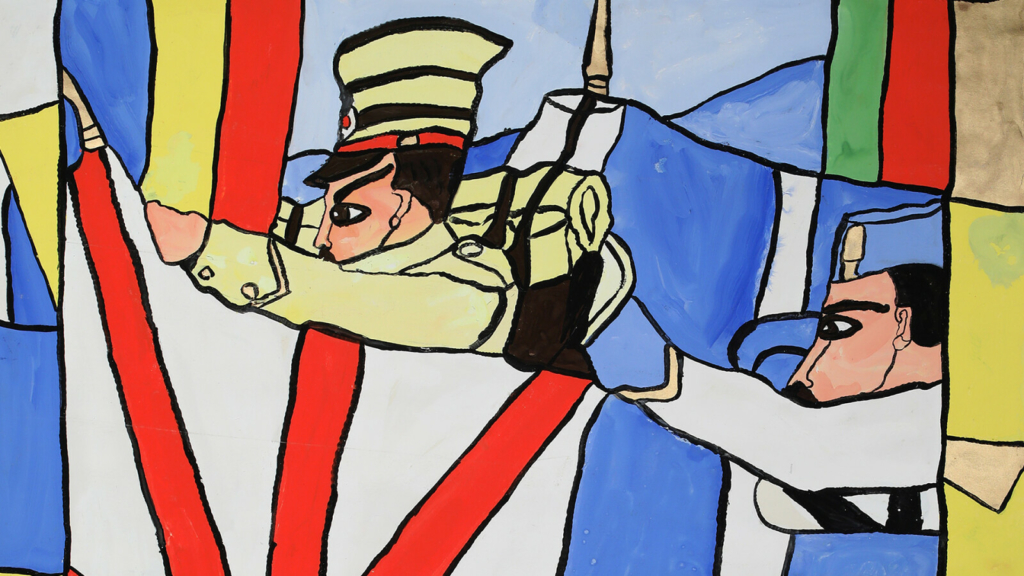
And the war was horrendous

Article categories: Museums & Folklore
And the war was horrendous focuses on battle themes inspired by the 170th anniversary of the Skirmish of Halkokari.
And the War Was Horrendous is inspired by a locally significant battle of the Crimean War, the Skirmish of Halkokari fought in 1854. Inspired by the lyrics of the song Oolannin sota (The Åland War) about the war in the Baltic Sea, the exhibition takes viewers into the atmosphere of warfare.
The exhibition explores the theme of battle by presenting works from the collections of the City of Kokkola. The interpretations on display relate to the subject of war but stem from different points of view and eras. Some of the exhibited artists have experienced the terrors of war on a personal level, some document what they have seen and read, while others use their art to protest. Some have worked in the margins of the art scene, producing war-related imagery while struggling to fit into the existing mould. These struggles emerge before us in a multitude of ways, challenging us to reflect on the mental landscapes and recollections that they reveal.
And the War Was Horrendous highlights, among others, Veikko Vionoja’s charcoal and pencil drawings of the Winter War, Sigurd Wettenhovi-Aspa’s images exuding patriotism and depicting the War of Finland, as well as Jaakko Valo’s views on warfare stemming from pacifism. Josef Wittlich’s paintings depicting the First World War with a naïve pop-artism are inspired by other images and history books, while outsider artist Ilmari Salminen’s works using collage techniques feature the big names of the armed forces in the form of newspaper clippings.
The exhibition contains sensitive and even difficult aspects, it encourages reflection and examination of the canon of war images. The exhibition gives a voice to those who wore uniforms to battle, those who dreamed of doing so, and those who refused to take up arms. What is perceived to be the appropriate convention of depiction at any given time depends on the era, culture and personality. The exhibition is curated by the K.H.Renlund Museum’s curator of art, Katriina Meller.
PICTURE: Josef Wittlich, Japanese and Greek solider in profile with their respective flags, 1970–1975. Donation by Elke and Werner Zimmer, K. H.Renlund museum. Picture: Anna Katriina Puikko/KHRM
-
Time
17.5.2024 – 8.9.2024 11.00 – 16.00Event times
- 17.5.2024 11.00 – 16.00
- 18.5.2024 11.00 – 16.00
- 19.5.2024 11.00 – 16.00
- 21.5.2024 11.00 – 16.00
- 22.5.2024 11.00 – 16.00
- 23.5.2024 11.00 – 18.00
- 24.5.2024 11.00 – 16.00
- 25.5.2024 11.00 – 16.00
- 26.5.2024 11.00 – 16.00
- 28.5.2024 11.00 – 16.00
- 29.5.2024 11.00 – 16.00
- 30.5.2024 11.00 – 18.00
- 31.5.2024 11.00 – 16.00
- 1.6.2024 11.00 – 16.00
- 2.6.2024 11.00 – 16.00
- 4.6.2024 11.00 – 16.00
- 5.6.2024 11.00 – 16.00
- 6.6.2024 11.00 – 18.00
- 7.6.2024 11.00 – 16.00
- 8.6.2024 11.00 – 16.00
- 9.6.2024 11.00 – 16.00
- 11.6.2024 11.00 – 16.00
- 12.6.2024 11.00 – 16.00
- 13.6.2024 11.00 – 18.00
- 14.6.2024 11.00 – 16.00
- 15.6.2024 11.00 – 16.00
- 16.6.2024 11.00 – 16.00
- 18.6.2024 11.00 – 16.00
- 19.6.2024 11.00 – 16.00
- 20.6.2024 11.00 – 18.00
- 25.6.2024 11.00 – 16.00
- 26.6.2024 11.00 – 16.00
- 27.6.2024 11.00 – 18.00
- 28.6.2024 11.00 – 16.00
- 29.6.2024 11.00 – 16.00
- 30.6.2024 11.00 – 16.00
- 2.7.2024 11.00 – 16.00
- 3.7.2024 11.00 – 16.00
- 4.7.2024 11.00 – 18.00
- 5.7.2024 11.00 – 16.00
- 6.7.2024 11.00 – 16.00
- 7.7.2024 11.00 – 16.00
- 9.7.2024 11.00 – 16.00
- 10.7.2024 11.00 – 16.00
- 11.7.2024 11.00 – 18.00
- 12.7.2024 11.00 – 16.00
- 13.7.2024 11.00 – 16.00
- 14.7.2024 11.00 – 16.00
- 16.7.2024 11.00 – 16.00
- 17.7.2024 11.00 – 16.00
- 18.7.2024 11.00 – 18.00
- 19.7.2024 11.00 – 16.00
- 20.7.2024 11.00 – 16.00
- 21.7.2024 11.00 – 16.00
- 23.7.2024 11.00 – 16.00
- 24.7.2024 11.00 – 16.00
- 25.7.2024 11.00 – 18.00
- 26.7.2024 11.00 – 16.00
- 27.7.2024 11.00 – 16.00
- 28.7.2024 11.00 – 16.00
- 30.7.2024 11.00 – 16.00
- 31.7.2024 11.00 – 16.00
- 1.8.2024 11.00 – 18.00
- 2.8.2024 11.00 – 16.00
- 3.8.2024 11.00 – 16.00
- 4.8.2024 11.00 – 16.00
- 6.8.2024 11.00 – 16.00
- 7.8.2024 11.00 – 16.00
- 8.8.2024 11.00 – 18.00
- 9.8.2024 11.00 – 16.00
- 10.8.2024 11.00 – 16.00
- 11.8.2024 11.00 – 16.00
- 13.8.2024 11.00 – 16.00
- 14.8.2024 11.00 – 16.00
- 15.8.2024 11.00 – 18.00
- 16.8.2024 11.00 – 16.00
- 17.8.2024 11.00 – 16.00
- 18.8.2024 11.00 – 16.00
- 20.8.2024 11.00 – 16.00
- 21.8.2024 11.00 – 16.00
- 22.8.2024 11.00 – 18.00
- 23.8.2024 11.00 – 16.00
- 24.8.2024 11.00 – 16.00
- 25.8.2024 11.00 – 16.00
- 27.8.2024 11.00 – 16.00
- 28.8.2024 11.00 – 16.00
- 29.8.2024 11.00 – 18.00
- 30.8.2024 11.00 – 16.00
- 31.8.2024 11.00 – 16.00
- 1.9.2024 11.00 – 16.00
- 3.9.2024 11.00 – 16.00
- 4.9.2024 11.00 – 16.00
- 5.9.2024 11.00 – 18.00
- 6.9.2024 11.00 – 16.00
- 7.9.2024 11.00 – 16.00
- 8.9.2024 11.00 – 16.00
-
Place
Roos House Pitkäsillankatu 39, 00000 Show route on map -
Organizer
K.H.Renlund Museum museo@kokkola.fi http://khrenlundmuseum.fi